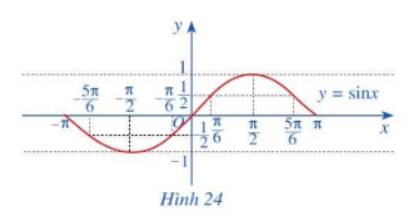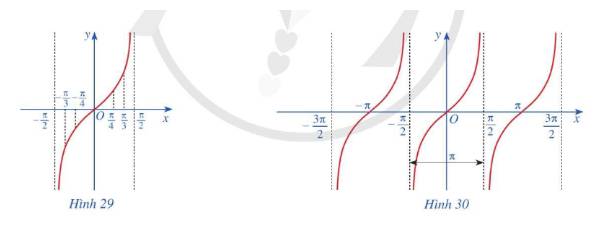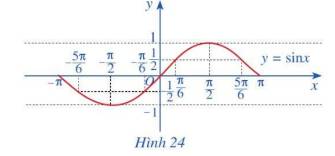tìm các giá trị của \(x\in[-\pi;2\pi]\)để cos x=0
Hãy nhập câu hỏi của bạn vào đây, nếu là tài khoản VIP, bạn sẽ được ưu tiên trả lời.


a)
x | \( - \frac{\pi }{3}\) | \( - \frac{\pi }{4}\) | 0 | \(\frac{\pi }{4}\) | \(\frac{\pi }{3}\) |
\(y = \tan x\) | \( - \sqrt 3 \) | -1 | 0 | 1 | \(\sqrt 3 \) |
b) Trong mặt phẳng tọa độ Oxy, hãy biểu diễn các điểm (x; y) trong bảng giá trị ở câu a. Bằng cách làm tương tự, lấy nhiều điểm (x; tanx) với \(x \in \left( { - \frac{\pi }{2};\frac{\pi }{2}} \right)\) và nối lại ta được đồ thị hàm số \(y = \tan x\) trên khoảng \(\left( { - \frac{\pi }{2};\frac{\pi }{2}} \right)\) (Hình 29).
c) Làm tương tự như trên đối với các khoảng \(\left( {\frac{\pi }{2};\frac{{3\pi }}{2}} \right),\left( { - \frac{{3\pi }}{2}; - \frac{\pi }{2}} \right)\),...ta có đồ thị hàm số \(y = \tan x\)trên D được biểu diễn ở Hình 30.


a.Ta có : \(x\in\left(\pi;\dfrac{3}{2}\pi\right)\Rightarrow cosx< 0\)
\(cosx=-\sqrt{1-sin^2x}=-\sqrt{1-0,8^2}=-0,6\)
\(tanx=\dfrac{4}{3};cotx=\dfrac{3}{4}\)
b. cos 2x = \(cos^2x-sin^2x=0,6^2-0,8^2=-0,28\)
\(P=2.cos2x=-0,56\)
\(Q=tan\left(2x+\dfrac{\pi}{3}\right)=\dfrac{tan2x+tan\dfrac{\pi}{3}}{1-tan2x.tan\dfrac{\pi}{3}}=\dfrac{tan2x+\sqrt{3}}{1-tan2x.\sqrt{3}}\)
tan 2x = \(\dfrac{2tanx}{1-tan^2x}=\dfrac{\dfrac{2.4}{3}}{1-\left(\dfrac{4}{3}\right)^2}=\dfrac{-24}{7}\)
\(Q=\dfrac{-\dfrac{24}{7}+\sqrt{3}}{1+\dfrac{24}{7}.\sqrt{3}}\) \(=\dfrac{-24+7\sqrt{3}}{7+24\sqrt{3}}\)

Đồ thị của hàm số \(y=sin\left(x\right)\) trên đoạn \(\left[-\pi;\pi\right]\) là:

Ta thấy đồ thị hàm số giao với đường thẳng d: \(y=\dfrac{1}{2}\) tại 2 điểm.
Do đó, phương trình \(sin\left(x\right)=\dfrac{1}{2}\) có hai giá trị \(x\in\left[-\pi;\pi\right]\) thỏa mãn

1.
\(\Leftrightarrow1-2sin^2x+sinx+m=0\)
\(\Leftrightarrow2sin^2x-sinx-1=m\)
Đặt \(sinx=t\Rightarrow t\in\left[-\dfrac{1}{2};\dfrac{\sqrt{2}}{2}\right]\)
Xét hàm \(f\left(t\right)=2t^2-t-1\) trên \(\left[-\dfrac{1}{2};\dfrac{\sqrt{2}}{2}\right]\)
\(-\dfrac{b}{2a}=\dfrac{1}{4}\in\left[-\dfrac{1}{2};\dfrac{\sqrt{2}}{2}\right]\)
\(f\left(-\dfrac{1}{2}\right)=0\) ; \(f\left(\dfrac{1}{4}\right)=-\dfrac{9}{8}\) ; \(f\left(\dfrac{\sqrt{2}}{2}\right)=-\dfrac{\sqrt{2}}{2}\)
\(\Rightarrow-\dfrac{9}{8}\le f\left(t\right)\le0\Rightarrow-\dfrac{9}{8}\le m\le0\)
Có 2 giá trị nguyên của m (nếu đáp án là 3 thì đáp án sai)
2.
ĐKXĐ: \(sin2x\ne1\Rightarrow x\ne\dfrac{\pi}{4}\) (chỉ quan tâm trong khoảng xét)
Pt tương đương:
\(\left(tan^2x+cot^2x+2\right)-\left(tanx+cotx\right)-4=0\)
\(\Leftrightarrow\left(tanx+cotx\right)^2+\left(tanx+cotx\right)-4=0\)
\(\Rightarrow\left[{}\begin{matrix}tanx+cotx=\dfrac{1+\sqrt{17}}{2}\\tanx+cotx=\dfrac{1-\sqrt{17}}{2}\left(loại\right)\end{matrix}\right.\)
Nghiệm xấu quá, kiểm tra lại đề chỗ \(-tanx+...-cotx\) có thể 1 trong 2 cái đằng trước phải là dấu "+"

a)
x | \( - \pi \) | \( - \frac{{5\pi }}{6}\) | \( - \frac{\pi }{2}\) | \( - \frac{\pi }{6}\) | 0 | \(\frac{\pi }{6}\) | \(\frac{\pi }{2}\) | \(\frac{{5\pi }}{6}\) | \(\pi \) |
\(y = \sin x\) | 0 | \( - \frac{1}{2}\) | -1 | \( - \frac{1}{2}\) | 0 | \(\frac{1}{2}\) | 1 | \(\frac{1}{2}\) | 0 |
b) Trong mặt phẳng Oxy, hãy biểu diễn các điểm \(\left( {x;y} \right)\) trong bảng giá trị ở câu a. Bằng cách làm tương tự, lấy nhiều điểm \(\left( {x;\sin x} \right)\) với \(x \in \left[ { - \pi ;\pi } \right]\) với nối lại ta được đồ thị hàm số \(y = \sin x\) trên đoạn \(\left[ { - \pi ;\pi } \right]\)(Hình 24).

c) Làm tương tự như trên đối với các đoạn \(\left[ { - 3\pi ; - \pi } \right]\), \(\left[ {\pi ;3\pi } \right]\),...ta có đồ thị hàm số \(y = \sin x\)trên R được biểu diễn ở Hình 25.


Do \(\sqrt{\pi}>1\) nên theo tính chất về lũy thừa số thực, ta có :
* Vì \(\cos x\ge1,x\in R\) nên \(A=\left(\sqrt{\pi}\right)^{\cos x}\ge\left(\sqrt{\pi}\right)^{-1}=\frac{1}{\sqrt{\pi}}\)
Giá trị nhỏ nhất của A là \(\frac{1}{\sqrt{\pi}}\) đạt được khi \(\cos x=-1\Leftrightarrow x=\pi+2k\pi,k\in Z\)
* Vì \(\cos x\le1,x\in R\) nên \(A=\left(\sqrt{\pi}\right)^{\cos x}\le\left(\sqrt{\pi}\right)^1=\sqrt{\pi}\)
Giá trị nhỏ nhất của A là \(\sqrt{\pi}\) đạt được khi \(\cos x=1\Leftrightarrow x=2k\pi,k\in Z\)

\(a,,0< x< \dfrac{\pi}{2}\\ \Rightarrow\left\{{}\begin{matrix}sinx>0\\cosx< 0\end{matrix}\right.\\ 1+tan^2x=\dfrac{1}{cos^2x}\\ \Rightarrow cos^2x=\dfrac{1}{4}\\ \Rightarrow cosx=-\dfrac{1}{2}\)
\(sin^2x+cos^2x=1\\ \Rightarrow sin^2x=1-\left(-\dfrac{1}{2}\right)^2\\ =\dfrac{3}{4}\\ \Rightarrow sinx=\dfrac{\sqrt{3}}{2}\)
\(tanx.cotx=1\\ \Rightarrow cotx=1:\sqrt{3}\\ =\dfrac{\sqrt{3}}{3}\)
\(b,\dfrac{3\pi}{2}< x< 2\pi\\ \Rightarrow\left\{{}\begin{matrix}sinx< 0\\cosx>0\end{matrix}\right.\)
\(tanx.cotx=1\\ \Rightarrow tanx=-1\)
\(1+cot^2x=\dfrac{1}{sin^2x}\\ \Rightarrow sin^2x=\dfrac{1}{2}\\ \Rightarrow sinx=-\dfrac{\sqrt{2}}{2}\\ cos^2x+sin^2x=1\\ \Rightarrow cos^2x=\dfrac{1}{2}\\ \Rightarrow cosx=\dfrac{\sqrt{2}}{2}\)



Có \(cosx=0\)
\(\Rightarrow x=\frac{\pi}{2}+k\)
Và \(-\pi\le x\le2\pi\)
\(\Leftrightarrow-\pi\le\frac{\pi}{2}+k\le2\pi\)
\(\Leftrightarrow-2\pi\le\pi+2k\le4\pi\)
Với \(\pi,k\in Z\)
Làm đại thôi!